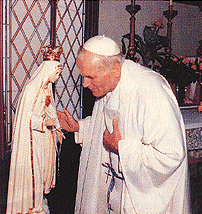

Karol Wojtyla, the future Pope, was born on May 18, 1920 at Wadowice, Poland. For many years Karol believed God was calling him to the priesthood, and after two near fatal accidents, he responded to God's call. He studied secretly during the German occupation of Poland, and was ordained to the priesthood on November 1, 1946. In these years he came to know and practice the teachings of St. Louis Marie de Montfort and St. John of the Cross. He earned a doctorate in theology in 1948 at the Angelicum in Rome, Italy.
From 1948 to 1951 he served as a parish priest in the Krakow diocese and then returned to study philosophy at the Jagiellonian University at Krakow. From 1952 to 1958 Karol Wojtyla taught social ethics at the Krakow Seminary. In 1956 he became also a professor at the University of Lublin. Venerable Pope Pius XII appointed Karol Wojtyla an auxiliary bishop in Krakow on July 4, 1958. Servant of God, Pope Paul VI appointed him Archbishop of Krakow on December 30, 1963.
As Archbishop of Krakow, Karol Wojtyla proved himself a noble and trustworthy pastor in the face of Communist persecution. A member of the prepatory commission, he attended all four sessions of Vatican II and is said to have written Gaudium et spes, the document on the Church in the Modern World. He also played a prominent role in the formulation of the Declaration on Religious Freedom. Following the Council, the Servant of God, Pope Paul VI, appointed Karol Wojtyla a Cardinal of the Roman Church on June 26, 1967.
In 1960 he published his most famous written work, Love and Responsibility. Pope Paul VI, delighted with its apologetical defense of the traditional catholic teaching of marriage, relied extensively on Archbishop Wojytla's counsel in writing Humanae Vitae. In 1976 he was invited by Pope Paul VI to preach the lenten sermons to the members of the Papal Household.
On October 16, 1978, Archbishop Wojtyla became the first non-Italian pope since Hadrian VI (1522-3). He took the name of his predecessors (John, Paul, John Paul) to emphasis his desire to continue the reforms of the Council.
Pope John Paul II is the most traveled pope in the history of the papacy, having visited nearly every country in the world which would receive him. As the Vicar of Christ he has consecrated each place that he has visited to the Blessed Virgin Mary. On May 13, 1983 he went to Fatima to consecrate the world to the Immaculate Heart of Mary. In October of the same year he canonised St. Maximilian Mary Kolbe, Apostle of Unlimited Consecration to Mary Immaculate. In 1983, He repeated the consecration of the world to Mary in union with all the Bishops of the Catholic Church, in fulfilment of Our Lady's promises at Fatima.
On September 15, 1985, the Feast of Our Lady of Sorrows, the Holy Father gave an Angelus address to the faithful and pilgrims gathered at the Vatican. During this address, he characterised the everlasting covenant of salvation wrought by Jesus and Mary as "the Admirable Alliance of Hearts." The response of the faithful throughout the world was quick and profound. In many places, bishops, priests, religious, the laity and theologians began taking up this theme to radically and dramatically retell the good news of salvation. The very next year an international symposium was organised and convened at Fatima, Portugal, to discuss and promote this prophetic term chosen by the Pope. Another symposium was held in Manila, Philippines, under the auspices of Jaime Cardinal Sin, the Archbishop of Manila, in 1987.
In 1994 Pope John Paul II beatified Sister
Maria Faustina Kowalska of the Congregation of Our Lady of Mercy, giving for the first
time a formal approval to the life, work, and teachings of this secretary of the Divine
Mercy. In the summer of 1995, Pope John Paul II began a lengthy catechisis on the Blessed
Virgin Mary during his weekly Angelus addresses, culminating on October 25, 1995, with his
instruction on Our Lady's active participation in the Sacrifice of Calvary. This active
participation of Our Lady at Calvary is called the Co - redemption. Already in 1982
and 1985 Pope John Paul II used the term "co - redemptrix" in reference to Our
Lady in public addresses. This is significant, for he is the first Pope to do so since
Pope Benedict XV (1914-1920) at whose prayer Our Lady came to Fatima to reveal Her
Immaculate Heart. Since the time of Pope Benedict VX, this terminology was under review by
the Holy See; the present Pope's usage is a confirmation of this traditional view of
Mary's role in salvation history.
In response to this new initiative of Pope John Paul II, an international, theological
symposium on the Co-redemption is presently being organised by the Bishop of Campobasso
(IS), Italy, for the week of September 15, 1996.
(From the Alliance of the two hearts)
DEATH OF THE HOLY FATHER - Pope John Paul II
www.theworkofgod.org